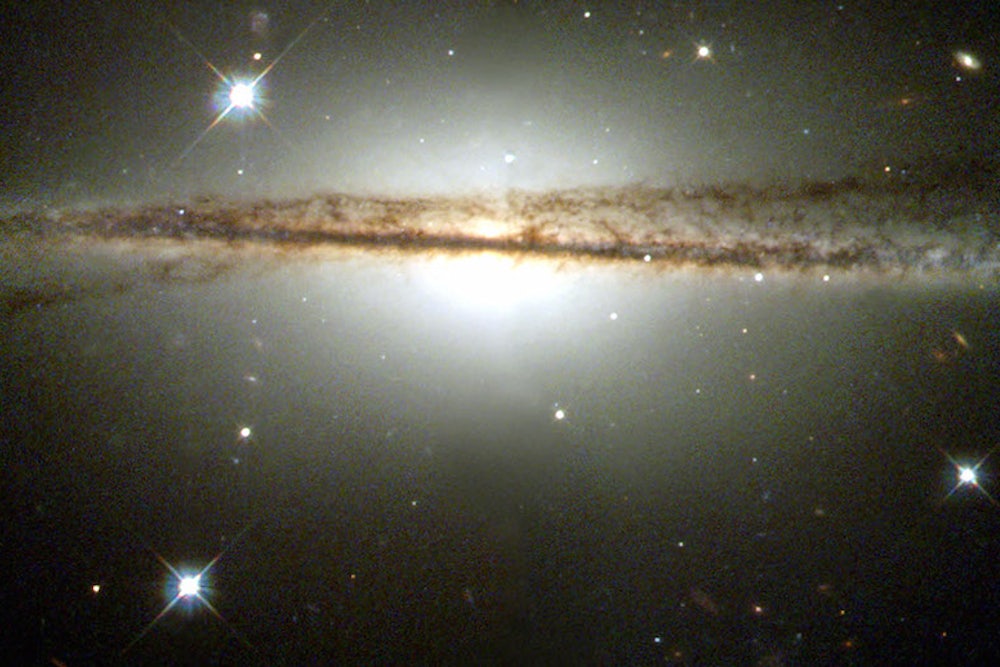Many people are fascinated by the idea of a multiverse—other universes not within our reach. But at least as fascinating are the many hidden worlds that we do have a chance to explore and understand. With the ideas and technology currently in the works, dark matter is poised to be the final frontier—or at least the next exciting one.

Dark matter is the elusive stuff in the Universe that interacts through gravity like ordinary matter, but doesn’t emit or absorb light. Astronomers detect its gravitational influence, but they literally don’t see or feel it. Dark matter carries five times the energy of ordinary matter, but its interactions with the matter we directly experience are extremely feeble. Probably billions of dark matter particles pass through each of us every second. Yet no one notices that they are there. The effect of even billions of dark matter particles on us is minuscule.
That’s because dark matter is not made out of the same material as ordinary matter—atoms or familiar elementary particles, whose interactions with light are responsible for everything we see. Dark matter is not dark—it is transparent. Dark things absorb light. Transparent stuff, including the unfortunately named dark matter, is oblivious to it. No one can collect it in a basement or garage.
Yet a screenwriter recently asked me about the potential for harnessing the power of dark matter. Despite our fascination with things dark—as evidenced by the many books and movies with the word in the title—dark matter is neither an ominous, nor a munificent, source of strategic power in our local neighborhood. With our hands and tools made from ordinary matter, we can’t produce dark matter missiles and we can’t create dark matter traps. Finding it is difficult enough. Harnessing it would be another thing altogether.
I’ll attribute the screenwriter’s wishful thinking to the poor choice of name, which perhaps makes dark matter seem more menacing and powerful than it is. But although people can’t harness the force of dark matter, the Universe can, Whether or not we recognize its contribution, dark matter—like the invisible workers who built pyramids or highways or assembled electronics that were essential to the development of civilization—has played an important role in the development of our cosmos. If my current research with collaborators proves correct, dark matter might also indirectly have paved the way for the emergence of large mammals and hence humanity.
Paleontologists, geologists, and physicists have shown that 66 million years ago, an object at least ten kilometers wide plummeted to Earth from space and destroyed the terrestrial dinosaurs, along with three-quarters of the other species on the planet. Our proposal is that during the Sun’s passage through the midplane of the Milky Way—the stripe of stars and bright dust that you can observe in a clear night sky—the Solar System encountered a disk of dark matter that dislodged the distant object, thereby precipitating this cataclysmic impact—and possibly others on 30-35 million year intervals. We hypothesize that a less conventional type of dark matter collapsed into a dense disk (denser even than that of the Milky Way) and the disk’s gravitational influence diverts the trajectories of comets when the Solar System passes through.
Our suggested dark matter content differs from the usual assumption about the nature of dark matter. While the visible world has a diversity of particle types—quarks and electrons and photons and gluons, for example—and these particles interact through different forces (electromagnetic, strong, and weak forces), physicists generally take all dark matter to be composed of a single type of particle that essentially interacts only through gravity. Why not suppose that different types of dark matter exist too, and that at least one type of dark matter experiences its own forces? If even a small fraction of dark matter particles interact with other dark matter particles through a dark electromagnetic force, then these dark matter particles would behave similarly to particles of ordinary matter, which we know in the galaxy cool, slow down in velocity, and form into a disk, like our visible Milky Way disk. By measuring the motion of a billion Milky Way stars, the currently operating GAIA satellite is creating a 3D picture of the shape of our galaxy, which would be sensitive to a dark matter disk’s gravitational influence today.
Whatever the outcome of the search for this additional type of dark matter, we know that dark matter was essential to the Universe we see. Despite the weakness of its interactions, the gravitational pull of dark matter formed the galaxies and galaxy clusters that are spread throughout the cosmos. Without dark matter, stars wouldn’t have reached their current population and distribution. We wouldn’t be around to comment on any of this, let alone put together a coherent picture of the Universe’s evolution, if dark matter hadn’t been present, allowing enough time to form the structure that we now observe.
In one of the most amazing discoveries of the twentieth century, observations of the relic radiation from the Big Bang showed that when the Universe was roughly the size of a grain of sand, very tiny deviations in density were present. These tiny fluctuations-at a level of less than 0.001 percent—were ultimately the origin of you, me, galaxies, and all the structure in the Universe. Dark matter played an essential role in enhancing these small variations in density and allowing these cosmic structures to form.
Matter, unlike radiation, could slow down in the early Universe and clump together. The gravitational pull where its density is greater caused some regions of matter to collapse, thereby further increasing matter density and initiating the formation of galaxies. The Universe then grew lumpier as the (matter-) rich regions got richer and the (matter-) poor domains got poorer. The aggregation of matter continued, as matter continued collapsing in a positive feedback process, transforming the initially homogeneous Universe into what would ultimately be amplified into the differentiated galaxies, clusters, and stars we see today. Because there is so much more dark matter than ordinary matter, this collapse happened earlier than it would have had there been only ordinary matter in the Universe. This is important because it gave the structure we see today enough time to grow.
But dark matter was also important for another reason. Even when it isn’t the chief form of energy in the Universe, radiation washes out density variations in ordinary matter, much as wind erases ripples of sand imprinted on a beach. The radiation in the early Universe would have prevented galaxy-sized objects formed solely of ordinary matter from being created.
Dark matter could initiate such structures undeterred, since it is immune to electromagnetic radiation. Dark matter therefore effectively gave ordinary matter an additional head start, paving the way for the formation of galaxies and stellar systems. Only by hitchhiking with dark matter could galaxy-sized objects and the seeds of stars in our Universe form. When a sufficiently large region collapsed, dark matter formed a roughly spherical halo inside of which the gas of ordinary matter could cool, condense into the center, and eventually fragment into stars.
This simultaneous collapse of dark matter and ordinary matter helps with the search for dark matter too. Though we see stars and galaxies because of emitted light, dark matter is what initially attracted the visible matter to form these structures. So even though we directly see only ordinary matter, we can be pretty confident that dark matter and ordinary matter exist in the same places and that dark matter remains in this spherical halo around visible matter. So, in a sense, looking under the lamppost for dark matter is appropriate.
Dark matter continues to make a difference in the cosmos. Not only does dark matter contribute to the gravitational attraction that keeps stars from flying away, but it also attracts some of the matter that is ejected by supernovae back into galaxies. Dark matter thereby helps retain heavy elements that are essential to further star formation and ultimately to life.
No one should worry about “dark”'s needlessly negative connotations or dark matter’s superior powers. The influence of a dark matter particle—or even billions of them—can be ignored. But the gravitational influence of a sufficiently large amount of dark matter aggregated into a concentrated region has had a substantial influence—one that has been critical to the Universe’s development. As with the other unnoticed populations in our midst, dark matter was essential to our world, and according to our recent research, might possibly have been essential to the emergence of human life.
My colleagues and I have only begun to scratch the surface in understanding what dark matter might be. Dark matter is not separated in space so the Starship Enterprise won’t transport us there—though unlike the Starship Enterprise, dark matter is real. But research today promises to transcend our physical limitations and better understand the elusive, but potentially accessible, world of dark matter.
Excerpted from Dark Matter and the Dinosaurs. Copyright © 2015 by Lisa Randall, used by permission of The Wylie Agency LLC.
